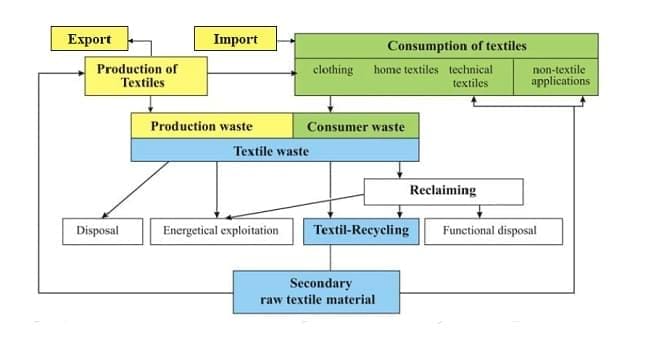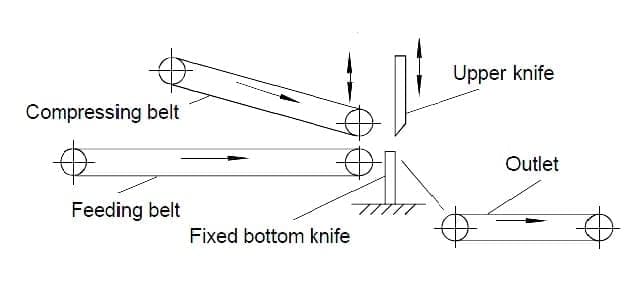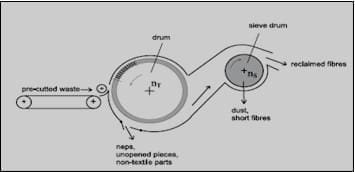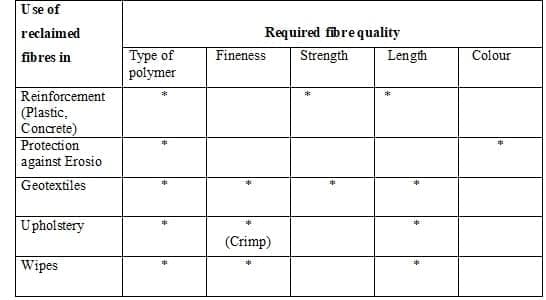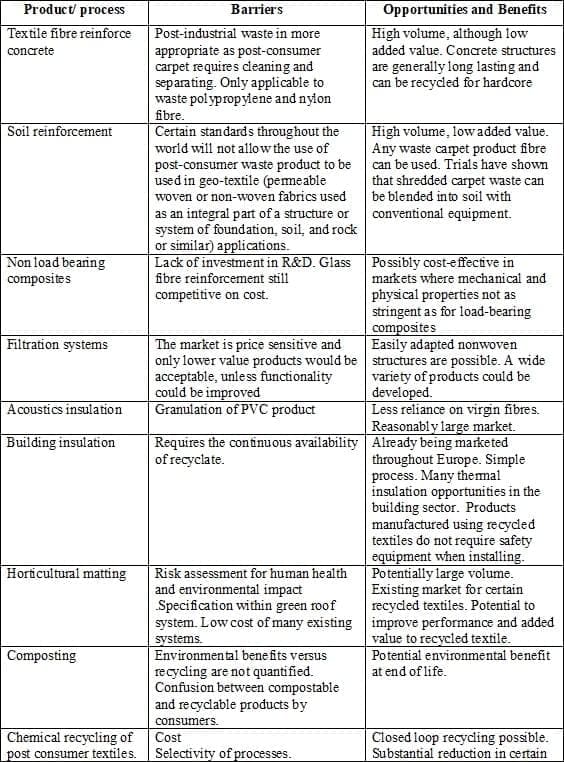Rahul Gadkari & M.C. Burji
D.K.T.E’S Textile and Engineering Institute,
Ichalkaranji-416115 (India)
Email-text.rahulgadkari@gmail.com.
Abstract:
As we move forward to the 21st century the textile product industries are facing with a monumental challenge and an opportunity, what to do with textile waste? Recycling of non hazardous solid textile waste may be viable alternative for industries. Recycling must be an integrated effort a partnership with consumer retailer, manufacturer, recyclers and government. The market acceptance of recycler textile includes the willingness of manufacture to participate in research development and production of recycled into new products, as well as increasing retailer and consumer awareness and demand for these product category.
Key words: Resource, textile waste, waste management & recycling types
- Introduction
The textile recycling industry is one of the oldest and most established recycling industries in the world; yet few people understand the industry, its myriad players, or reclaimed textile products in general throughout the world, used textile and apparel products are salvaged as reclaimed textiles and put to new uses. [1] In general, applications of fibers belong to the following three broad categories: apparel, home furnishing, and industrial. Most of the fiber products are for short term (e.g. disposables) to medium term (e.g. apparel, carpet, automotive interior) use, lasting up to a few years in their service life.
Textile industry has a long history of being thrifty with its resources; a large proportion of unnecessary waste is still produced each year. Commercially, textile waste generation is influenced by the production of textile goods, higher the production, the greater the amount of waste. This is in turn a function of consumer demand, which is influenced by the state of the economy.
Nowadays, the consumption of synthetic polymers has increased rapidly. This is because these materials have many advantageous properties over other materials including glass, metals, ceramics and woods. For example, they are lightweight, resistant to chemicals and environmental atmosphere. Furthermore, they can be easily processed into desired products by many methods.
- Types of Textile Waste
Textile waste can be classified as either pre-consumer or postconsumer waste; Pre-consumer waste consists of by-product materials from the textile fiber, and cotton industries that are re-manufactured for the automotive, aeronautic, home building, furniture, mattress, coarse yarn, home furnishings, paper, apparel and other industries. Postconsumer waste is defined as any type of garment or household article made from manufactured textiles that the owner no longer needs and decides to discard. These articles are discarded either because they are worn out, damaged, outgrown, or have gone out of fashion. [2]
Fig.1: Textile waste and possibility of recycling
- Waste Management
In general, there are four ways of handling the waste. In order of priority [3]
3.1 Source Reduction
To have little or even zero waste Source Reduction is generally the first step that should be considered in an integrated waste management system e.g. avoiding waste generation, internal reuse of waste, reuse in other products etc.
3.2 Incineration
It is a process of burning the solid waste to recover the heat energy. Textile waste e.g. short, shredded, loose fibres can also be reincorporated into a palatalized fuel. But, Incinerator chimneys emit organic substances such as dioxins, heavy metals, acidic gases and dust particles, which are all potentially harmful to both humans and the environment. Also, there is a problem disposing of residual ash which is likely to contain a concentration of toxic material.
3.3 Land Fills
It should be the last alternative in an integrated waste management system. Textile waste in landfill contributes to the formation of leach-ate as it decomposes, which has the potential to contaminate both surface and groundwater sources. Another product of decomposition in landfill is methane gas, which is a major greenhouse gas and a significant contributor to global warming, although it can be utilized if collected. The decomposition of organic fibres and yarn such as wool produces large amounts of ammonia as well as methane. Ammonia is highly toxic in both terrestrial and aquatic environments, and can be toxic in gaseous form. It has the potential to increase nitrogen in drinking water, which can have adverse effect on humans. Cellulose-based synthetics decay at a faster rate than chemical-based synthetics. Synthetic chemical fibres can prolong the adverse effects of both leach-ate and gas production due to the length of time it takes for them to decay.
3.4 Recycling
Recycling is a key concept of modern waste management. Recycling is the reprocessing of waste materials into new or reusable products. Ninety-nine percent of used textiles are recyclable. In many applications, especially where metals, glass or polymers (including synthetic textile materials) are involved, the recycling process can only slow down damage to the planet.
The least expensive and least adverse effect on the environment is when a component can be recycled into its original product, i.e. so called ‘closed loop’ recycling. The second best is when it can be used in another article which usually requires less demanding properties, for example face car seat fabric being recycled into backing material. Typically, recycling technologies are divided into primary; secondary, tertiary. Primary approaches involve recycling a product into its original form; secondary recycling involves melt processing a plastic product into a new product that has a lower level of physical, mechanical and/or chemical properties. Tertiary recycling involves processes such as pyrolysis and hydrolysis, which convert the plastic wastes into basic chemicals or fuels. Recycling can be divided into two types: chemical recycling and physical recycling. The principle of chemical recycling is to convert high molecular weight polymers into low molecular weight substances via chemical reactions. The obtained substances can be used as the reactants for preparations of other chemicals and polymers. In the case of physical recycling, manufacturing wastes and post-consumer products are reprocessed generally into new products using reclamations process or commingled plastics waste processing. Due to its simpler, cheaper and more environmental friendly process, physical recycling is more favourable than chemical recycling.
- 4. Advantages of Recycling
- Reducing environmental load through the efficient use of resources, energy and the recycling of used products.
- Recycling include petroleum savings, greenhouse gases reduced, energy conserved.
- Reduces the need for landfill space.
- Reduces pressure on virgin resources.
- Results in less pollution and energy savings, as fibers do not have to be transported.
- Recycling Technology:
The recycling of resources can be broadly divided into thermal, material and chemical sectors. In the fiber and textile industry, thermal recycling is intended to recover heat energy generated from the incineration of fiber wastes as thermal or electrical energy. Material recycling recovers polymers from fibers or plastics, and at present, the idea of transforming polyethylene terephthalate (PET) into fibers is most economical and widely used for practical purposes. Chemical recycling recovers monomers from waste fibers by polymer decomposition. Impurities can be easily removed from recovered monomers, so their quality will be made exactly equal to virgin monomers.
Table 1: Comparison of recycling technologies
- Recycling of Non-Woven’s
6.1 Non woven recycling process for reclaimed fibres [5]
step1– cutting of non woven waste in to pieces. The following figure no.2 describes the basic cutting machine principle.
Fig 2: Cutting machine
Step 2- processing of this cut pieces in to tearing machine to get reclaimed fibres
Fig 3: Tearing machine and pin coated tearing cylinder
Fig.4: Reclaim fibres with different lengths
6.1.2 Use of reclaimed fibres in technical textile
Table 2: Use of reclaimed fibres in Technical Textile. [5]
6.2 Re-granulation from non woven textiles
All the type of non woven waste from thermoplastic fibres such as polyethylene, polypropylene, polyamide, polyester etc. can be processed on agglomeration plants so as to make free-flowing granulates. The granulate can also be used to produce fibres (generally, for lower-value application). Important characteristics for the workability of the granulates are sufficient melt viscosity, bulk density and flow ability. They can be used as heavy-insulation layers (sprinkled onto or sintered onto the backs of molded parts or floor covering) or as a powdery binder agent to substitute phenolic resin when producing thermally bonded nonwovens and mats. The re-granulation machines employ the principles of grinding rapidly, agitating continuously, milling and fractioning to be heated with multi-knives and cooling and contracting. It produces granules from waste materials and angle materials such as the plastics film, filament. Ribbons, pieces, soft plastic pipes, foaming materials, and degrading materials, and puts then into reproduction. It is the latest ideal granulating equipment to recycle thermoplastics textiles and reproduce. [6]
- Composite recycling
Fiber reinforced composite materials have enormous potential in the construction, transport and wind energy sectors because of their durability, light weight and ability to be manufactured in complex shapes. The steady increase in the use of composites has brought benefits in many areas. Several research projects have been carried out to develop recycling processes and seek ways of effectively using recycling material in new existing applications. In most cases this will be glass fibre reinforced polyester and carbon fibre reinforced epoxy, and will be referred to as GFRP/CFRP (glass/ carbon fibre reinforced polymers) there are also thermoset composites using aramid, natural and other fibres, but volumes are currently small in comparison with glass and carbon. [7]
- Recycling methods for composites
8.1 Mechanical grinding
GFRP recycling has tended to focus on mechanical grinding of the cured composite material. After suitable size reduction, the materials are ground in a hammer mill or similar and graded into different fractions. [7]
8.2 Pyrolysis
Many of the CFRP recycling projects have centered around a partial pyrolysis process, where the resin matrix is burned off with limited oxygen. Carbon fibres processed in this way retain 90% or more of their original mechanical properties. This process has been commercialized by recycled carbon fibre (RCF). Variants of pyrolysis have been trailed in several places around the world for both glass and carbon fibre composites. A pyrolysis process for GFRP recycling was developed at the University of Leeds in a method where the fluid pyrolysis products can be used as fuel.
8.3 Fluidised bed
This process was developed at Nottingham University and involves feeding scrap composite pieces, reduced to about 25 mm, into a bed of sand. [7] The sand is fluidized with a stream of hot air at 450-5500C .The polymer breaks down and vaporizes, releasing the fibres and filler which are carried out in the gas stream. The fibres and filler are separated out, and the resin products are fully oxidized in a combustion chamber, where the heat energy can be recovered. This process can be used for both carbon and glass fibres composites. Glass fibres lose about 50% of their tensile strength but retain their stiffness if processed at 4500C, which is sufficient to remove polyester resin. At higher temperatures more strength is lost. Carbon fibres show strength loss of about 20% when processed at 5500C (suitable for epoxy resin), retaining original stiffness. A particular advantage of the fluidized bed process is that it is very tolerant of mixed and contaminated materials.
9 Applications of recycled carbon and glass fibres from composite
Research has been undertaking and is ongoing to assess feasibility of applying composite recyclate in a wide variety of applications, but few application routes have been commercialized as yet. Recycled carbon fibre sell recycled milled. chopped and pelletised carbon fibres in competition with virgin fibre products. [7]
Applications such as thermoplastic polymers- conductive, anti-static and reinforced, Anti-static paints and coatings, EMI shielding, Epoxy coatings in flotation modules, Composite tooling, Non-woven’s, high-temperature insulation, GFRP recyclate in roofing products, In molding compounds for automotive products and Pyrolysis-recovered glass fibres bound with polypropylene to form insulation slabs.
- Recycling of garments
10.1 Used Clothing Markets: Recovery from the waste stream includes re-use of a product in its original form; the largest volume of goods is sorted for second hand clothing markets. [1]
Fig.5 clothing’s are sorted for second hand clothing market
10.2 Conversion to new products
Two categories of conversion to new products will be used here. [1]
- i) Breakdown of fabric to fiber
Shoddy (from knits) and Mungo (from woven garments) are terms for the breakdown of fabric to fiber through cutting, shredding, carding, and other mechanical processes. The fiber is then re-engineered into value-added products. These value-added products include stuffing, automotive components, and carpet underlay’s, building materials such as insulation and roofing felt, and low-end blankets.
- ii) Re-design of used clothing.
The other category for conversion to new products is the actual re- design of used clothing. Current fashion trends are reflected by a team of young designers who use and customize second-hand clothes for a chain of specialty vintage clothing st
10.3 Wiping and polishing cloths
Clothing that has seen the end of its useful life as such may be turned into wiping or polishing cloths for industrial use. T-shirts are a primary source for this category because the cotton fiber makes an absorbent rag and polishing cloth.
- Summary of major textile recycling opportunities
Table3: Summary of major textile recycling opportunities [4]
- Conclusion
The environmental benefits gained from using recycled raw materials rather than virgin materials.The textile recycling industry continues to search for new viable value-added products made from used textile. Several research projects have been carried out to develop recycling processes and seek ways of effectively using recycling material in new existing applications.
Acknowledgement
We are very much thankful to the institute for giving us the permission to publish this paper.
Reference
- Youjiang Wang, “Recycling in textiles” The Textile institute woodhead publishing limited, Cambridge England.
- Artjom Roznev, “Recycling in textiles” HAMK University of Applied Sciences Supply Chain Management.
- www.tex waste-net\wasteguide waste – management & history types of waste.htm
- Oakdene Hollins Ltd. “Maximising Reuse and Recycling of UK Clothing and Textiles”, A research report completed for the Department for Environment, Food and Rural Affairs, October 2009
- Dipl.-ing Bernd Gulich, “Textile waste management in Germany and developments in textile recycling technology” Sachsischen textilforschungsinstitut e.v. an der Technischen Universitat chemritz,Germany.
- Machine manual of China Daoshang Group Wenzhou Plastic Machinery Co., Ltd.
- “Composite recycling summery of recent research and development”, Materials KTN report, September 2010
- “Composite recycling and Disposal an Environmental R&D Issue”, Boeing Environmental Technote, November 2003, vol.8, number4.


